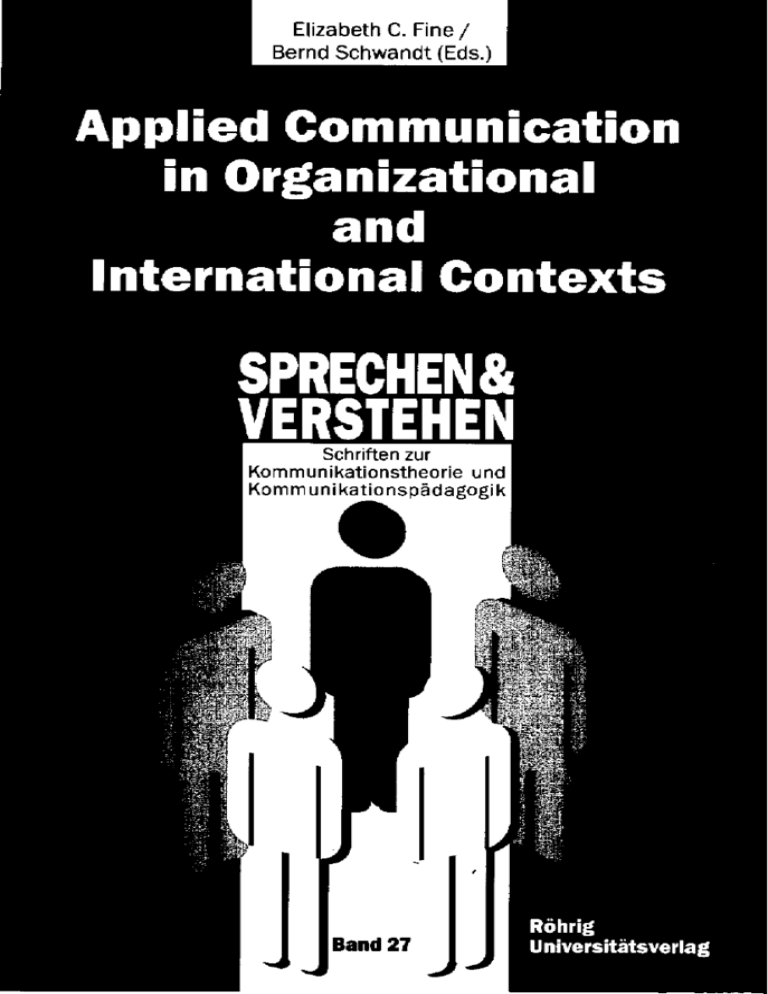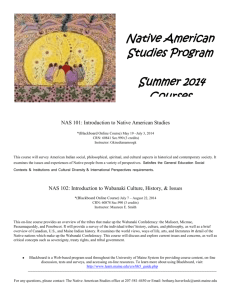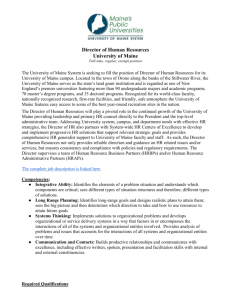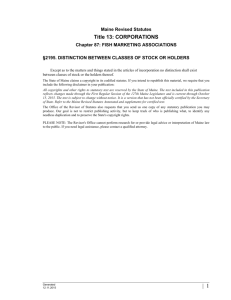ICC2006Lindenfeld
advertisement

Elizabeth C. Fine I Bernd Schwandt • Applied Communication in Organizational and International Contexts SPRECHEN& VERSTEHEN Schriften zur Kommunikationstheorie und Kom m u n i kationspadagogi k Band 27 87 Laura LINDENFELD Permeable Boundaries: Project Opportunity as a Bona Fide Group Since its inception in 2002, Project Opportunity at the University of Maine has trained teachers and other teaching personnel such as principals, guidance counselors, and educational technicians in Maine's K-12 public schools to work with students who are English language learners (ELL).1 Maine's rural nature, geographic breadth, and widespread poverty pose specific social, economic, and educational challenges to these students and place them at risk for failing in the educational system. The project's overarching goal is to ensure that teachers are prepared to assist ELL students acquire academic language, develop their literacy, and achieve knowledge and proficiency in content areas in order to meet educational standards and participate as knowledgeable, educated citizens with strong aspirations for their futures. Project Opportunity provides a model for considering the role of group communication scholarship in applied public policy contexts in Maine. I argue that this case study exemplifies the importance of integrating applied communication scholarship into the implementation of the state's applied public policy activities in Maine. Likewise, applied public policy provides outstanding opportunities for communication studies to study group dynamics in applied communication contexts that address relevant policy issues. The U.S. federal government uses multiple terms to refer to students who have not achieved full proficiency in English. The most common term is "English as a Second Language" (ESL). This term is, however, misrepresentative, as many newcomers to the U.S. speak multiple languages. Thus, English might be the fourth or fifth language a student is learning. Likewise, the term "limited English proficient" defines these students from a position of lack. I prefer the term "English language learners" to talk about students. I use ESL to refer to the field of study and coursework leading to state teaching endorsement and certification. ICC 2006 88 Funded for $1,500,000 by the U.S. Department of Education under the Office of English Language Acquisition (OELA, Title III), this five year project has reached across Maine to provide services to school districts with high and low incidence populations of ELLs.2 Maine schools serve close to 5,000 ELL students from over 100 language groups. In addition to newcomers from across the globe, the state has significant populations of students from the FrancoAmerican (375 LEP [limited English proficient] students) and WabanakilNative-Aillerican (225 LEP students) communities whose performance on standardized tests qualifies them as English Language Learners. These groups are clustered in rural areas (with the exception of a large Franco-American population in Lewiston). The state's newcomer populations are concentrated in the southern part of the state, especially in Portland. Given rapid shifts in the numbers of new immigrants to Maine, especially in the community of Lewiston, where a large group of second wave Somali refugees began to settle in 2002, Project Opportunity has consistently had to redefine its relationship to the communities it serves and adjust the strategies it has employed to reach them. As a federally funded grant, Project Opportunity is required to maintain a strict focus on its goals and reporting responsibilities toward the U.S. Department of Education. George W. Bush's signing of the No Child Left Behind Act (NCLB) on January 8, 2002 enacted a standards-based education reform that called for greater accountability and annual measurements of student progress.3 At the same time, the 2 Project Opportunity was preceded by another professional development grant for ESL teachers, Project Mainestay, which was funded under Title VII. The project was operated by the same team of faculty and staff. Under George W. Bush, Title VII (Office of Bilingual Education & Minority Languages Affairs) projects were moved to Title III into the Office of English Language Acquisition. The move underlines a shift toward a politics of "English only" under the Bush administration. 3 NCLB has provoked a tremendous amount of well directed criticism. Critics point to the failure to fully fund the act, the inequitable distribution of resources, the inadequacy of standardized tests to gauge students' performance, narrow defmitions of research, the narrowing of curriculum, and limitations on local control of education. ELL scholars have been especially critical of this policy (Crawford, 2004). ICC 2006 89 project was determined to utilize these federal funds to serve its various constituents with flexibility, responsiveness, and respect for cultural contexts and individual needs. In order to serve these diverse, dispersed communities and simultaneously remain compliant under NCLB, Project Opportunity had to be adaptive, creative, and open to change. In this essay, I provide a descriptive analysis of Project Opportunity,'s organization and history to argue that the project exemplifies the notion of a bona fide group as defined by Putnam & Stohl (1990, 1995, 1996). Precisely because of its flexible boundaries, the project has enabled this small group to serve the many constituents with whom it shares interdependency, while maintaining its obligations toward the funding agency. Project Opportunity and Bona Fide Group Theory Since the mid 1990s, group communication has experienced significant revitalization. Lawrence Frey attributes this to the shift from the laboratory to the field, in other words, to groups' natural environments and contexts (Frey, 2002). Although researchers undertook the study of groups in context in earlier periods, the study of natural groups began to flourish in the 1990s, and the context in which groups exist became paramount. Putnam and Stohl were the first to articulate the notion of a bona fide group perspective that contrasts to the more traditional notion of groups as "containers," a model that assumed the relative impermeability of groups with established boundaries. Bona fide groups, in contrast, manifest themselves through two primary characteristics: they have "stable yet permeable group boundaries and interdependence with their relevant contexts" (Frey, 2002). Stable yet permeable boundaries implies that groups have some configuration, even a more formal one, to them, but it understands that these undergo reconfiguration, redefinition, and negotiation via the interaction of different group members and forces outside of the group. Interdependence with relevant contexts refers to the reciprocity that exists among a group, its constituents, and its environment. Since its inception, Project Opportunity has had to serve a range of constituents while still responding to the guidelines under NCLB: ICC 2006 90 teachers and teaching personnel; K-12 students and their families; and the Maine State Department of Education. Numerous organizations at the University of Maine have been involved in the project's genesis, including the Margaret Chase Smith Policy Center, the Intensive English Institute, the College of Liberal Arts and Sciences, the College of Education, and the Wabanaki Center. Two particular features of the project best exemplify it as a bona fide group: firstly, its overall design, in particular its relationship with the Portland School Department's Multilmgual and Multicultural Center; secondly, its relationship with the Wabanaki Center at the University of Maine. Project Design Configured to serve both low- and high-incidence populations of ELL students and to address the changing needs of Maine's school districts, Project Opportunity's overarching design reflects the key qualities of bona fide groups, especially with regard to its stable but permeable group boundaries. The project's three over-arching pillars were designed to increase the number and improve the quality of teachers and teaching personnel working toward a state Endorsement in English as a Second Language (ESL).4 1. The project provides three-credit courses at the graduate and undergraduate level for pre- and in-service teachers on an ongoing basis in order to support their completion of ESL and Bilingual Ed Endorsements. These courses are offered onsite in districts and on campus in the form of semester courses and one-week summer institutes. Three courses per year are offered online to reach teachers in rural areas. 2. Grassroots, hands-on technical support provides districts with ongoing, custom tailored support for their teachers and staff. Rural 4 Maine differentiates between a certification and an endorsement. Teachers must hold a certification granted by the state based on a set number of education and content area courses. In addition, certified teachers and pre-service teachers seeking certification can pursue an ESL endorsement requiring an additional 15 credit hours in ESL and a passing score on the ESL Praxis II exam. ICC 2006 91 districts with first-time ELL population are in special need of support, as each district serving ELL students must develop and maintain a "Lau plan"5 Higher incidence districts require content area workshops, information about new resources and materials, and Continuing Education Units for endorsed teachers. 3. Project Opportunity has provided stipends and support to fifteen University of Maine students who did not have English as their first language. This support enables the students to complete their teaching certification and find job placement in K-12 public schools that serve ELL students. In particular, the project's relationship with the Portland Schools Office of Multilingual and Multicultural Programs characterizes it as a bona fide group. Portland, Maine's largest city, serves the largest population of ESL students in the state. The Multilingual Program, with tremendous experience working with ELL students, has amassed resources for ESL teachers, families, and students, including a significant collection of multicultural literature and film. Project Opportunity's staff includes two consultants from Portland Schools Multilingual Office who work on the grant as outreach coordinators. These individuals, Donald Bouchard and Marguerite MacDonald, configured their workload so that they could contribute 20% of their time to the project. This has had a tremendous impact on Project Opportunity's ability to serve major popUlations of ESL teachers, as both Outreach Coordinators regularly visit districts with high- and low-incidence populations to help them configure their Lau plans, deliver onsite workshops, assess districts' needs, and offer institutes and courses. Even more, the Multilingual office, located two hours south of the University of Maine, has become a primary site for the delivery of en- 5 In response to the 1974 U.S. Supreme Court case, Lau v. Nichols, public schools are required to ensure equal access for students who are ELLs. According to Brown University's Language Laboratory, a Lau Plan includes the legal foundation, student assessments, an instructional plan, parental involvement, qualified personnel, a coordination plan, a budget, adjunct services, and other possible considerations for serving ELLs (See: Policy. Linking Language Policy to Practice). ICC 2006 92 dorsement courses in southern Maine, and the project has helped to strengthen and extend library resources available to these communities. The project's collaboration with Portland Schools allowed for the development of resources for large areas of southern Maine. Project Opportunity's flexible character enabled it to offer ongoing support to the Lewiston school district in a town that suddenly became the home of over 1000 Somali refugees in 2002. Via the project, Portland School Department offered valuable insight and experience to Lewiston teachers and administrators about providing support services to the newcomers to their community. In addition to workshops and site visits, Project Opportunity organized courses onsite at Lewiston High School each semester until a significant cohort of teachers had received their endorsements in ESL. Similarly, the project was designed to mentor and support new University of Maine faculty to teach ESL coursework and to institutionalize coursework on campus. This functioned primarily through a "training of trainers program," whereby younger faculty shadowed experienced faculty as they taught courses. The experienced faculty served as consultants to· help newer faculty develop and deliver courses. Furthermore, the implementation of online coursework enabled the project to reach teachers year-round, and one-week intensive summer institutes taught onsite throughout the state provided condensed opportunities for the completion of coursework. These courses, in particular, fostered strong relationships and networks amongst teachers. The group's flexible boundaries and interdependence with its constituents led to its ability to serve large numbers of diverse groups throughout the state. Through its bona fide group structure, the project made a significant impact on the training of ESL teachers in Maine. Its design stressed flexibility and permeability. The grant proposal outlined the need for distance technology and onsite institutes to help navigate large geographic distances within the state. After five years, the project has built a cohort ESL endorsed teachers who mentor each other through classes, online listservs, workshops, and conferences, thus strengthening the state's ability to serve its ESL populations. When the project began in 2002, 115 teachers held endorsements in ESL and Bilingual ICC 2006 93 Education. As of March 2007, the project has served 241 individuals, 150 of whom are currently undertaking efforts to complete their endorsements. Of the 309 currently endorsed teachers in the State of Maine, Project Opportunity has supported 61, and 25 have completed the necessary coursework to apply for endorsement. Project Opportunity alone has increased the number of endorsed teachers by 20%. Together with the University of Maine's initial Title VII grant, Project Mainestay, the number of completed endorsements totals 134. Since 2001, Projects Mainestay and Opportunity have provided support for 69.7% of all 194 newly Endorsed teachers in the state. Wabanaki Culture and Language In order to build relationships with Maine's Wabanaki schools and teachers, the project required a great degree of elasticity. The bona fide group structure provided a particularly effective model for working with Maine Indian Education schools. The majority of students in these schools are English Language Learners (ELLs).6 Similarly, these children tend to score below average on standardized tests, especially in the area of mathematics. 7 This performance, far from any reflection on the students' innate abilities, is related to cultural differences and issues of language proficiency. In order for Wabanaki students to succeed in public schools, they need teachers who understand their cultural and linguistic experience and who can develop and deliver culturally responsive pedagogy. Project Opportunity has established a strong working relationship with the University of Maine's Wabanaki Center, a gathering place for indigenous scholars engaged 6 As of March 2007, 60% (225) of students enrolled in Maine Indian Education schools (373) meet the criteria for "limited English proficiency" (Maine State Department of Education, 2007). 7 For the 2004-2005 academic year, Maine Indian Education schools (Beatrice Rafferty School, Indian Township School, and Indian Island School) reported that 0% of their 8th grade students met the state standard for science and technology compared with a state average of 15%. For mathematics, 8% of students at Indian Township School met the requirements, while 0% of students at the other two schools met the standard compared with a state average of27% (Maine State Department of Education). ICC 2006 94 in the work of advancing Wabanaki studies through teaching, research and publication. This connection has enabled the project to work with and alongside the Passamaquoddy and Penobscot communities, both of whom have their own schools, rather than to impose models onto them. 8 This level of collaboration called for a leadership structure that was flexible, sensitive, and negotiable from the outset. Project Opportunity was able to reconfigure its budget and send a faculty member, Professor Tod"Shockey, whose research focuses on ethnomathematics, to the Passamoquoddy community each semester to deliver mathematics courses to Indian Education teachers.9 Throughout the past years, Professor Shockey has increasingly gained the respect and trust of the community and the teachers and has been able to introduce new, effective models for teaching mathematics in culturally responsive ways. The bona fide group structure enabled the development of this collaborative model with the tribal school. The bona fide group structure has had additional benefits to the University of Maine and its partners. The close collaboration that grew between the project staff and the Wabanaki Center has led to the collaborative endeavors to secure external funding to support Wabanaki language preservation efforts. Faculty and staff from the Center were able to attend conferences on indigenous language and culture and produce new research. Likewise, the proj ect supported students from the Wabanaki communities to complete teaching certification 8 Wabanaki, literally "people of the dawn," is the term used to describe the Eastern federation of five Algonquian tribes: Abenaki, the Penobscot, the Maliseet, the Passamaquoddy, and the Mi'kmaq. Maine Indian Education has schools in the Penobscot and Passamaquoddy communities. 9 D'Ambrosio (1985) defmes ethnomathematics as "the mathematics which is practiced among identifiable cultural groups, such as national-tribal societies, labor groups, children of a certain age bracket, professional classes, and so on. Its identity depends largely on focuses of interest, on motivation, and on certain codes and jargons which do not belong to the realm of academic mathematics. We go even further in this concept of ethnomathematics to include much of the mathematics which is currently practiced by engineers, mainly calculus, which does not respond to the rigor and formalism developed in academic courses of calculus." ICC 2006 95 and endorsements. This is especially important given the dearth of people from the Wabanaki communities teaching in Maine's public school system. Only 31 of the state's 15,724 full-time teachers report that they are Native American (Maine State Department of Education). The project's flexible parameters have served the state in other ways. In 2006, the state's requirements for ESL Endorsement and Lau plans changed, leaving many school districts that were formerly in compliance out of compliance with state requirements for ESL endorsed teachers and updated Lau plans. Over the past five years, more towns have acquired ELL students in their school systems for the first time and are faced with the need to train a teacher in ESL in order to remain in compliance with state regulations. The project's flexible structure has allowed it to address changes in state requirements while still fulfilling its obligations toward the U.S. Department of Education. Summary The flexible boundaries of Project Opportunity demonstrate how communication studies can contribute to the improvement of state, regional, and local resources. Indeed it provides a model for linking applied communication studies with applied public policy activities. Projects such as the one outlined here offer models for integrating external funding opportunities with collaborative, innovative models that serve the state, provide external funding, and open new avenues for communication research. As scholars of communication, utilizing our methodologies and theories as tool boxes allows us to develop new models as we engage pertinent issues in our regions and states. This, in turn, provides us remarkably fruitful groundwork to connect our discipline to issues of public policy and underlines the importance of collaborating beyond the university's doorstep. Externally funded projects invite us to reconfigure our work, to include students in these processes, and to consider new objects of research and ways of thinking about these. ICC 2006 96 References: CRAWFORD, J. 2004. No Child Left Behind. Misguided Approach to School Accountability for English Language Learners, Center on Education Policy. D' AMBROSIO, U. 1985. Ethnomathematics and its place in the history and pedagogy of mathematic. In: For the Learning of Mathematics--An International Journal of Mathematics Education, 5(1),44-48. FREY, L. 2002. New Directions in Group Communication, Thousand Oaks, California FREY, L., GOURAN, D., AND SCOTT POOLE, M. 1999. The Handbook of Group Communication Theory and Research. Thousand Oaks, California. EDUCATION ALLIANCE AT BROWN, "Policy: Linking Language Policy to Practice for English Language Learners, <http://www.alliance.brown.edultdllpolicy/index.shtml> Cited on March 15, 2007. MAINE STATE DEPARTMENT OF EDUCATION, 2003-2004. Distribution by Race and Sex ofFull-tirrie Staff in Maine Public Schools. ICC 2006




